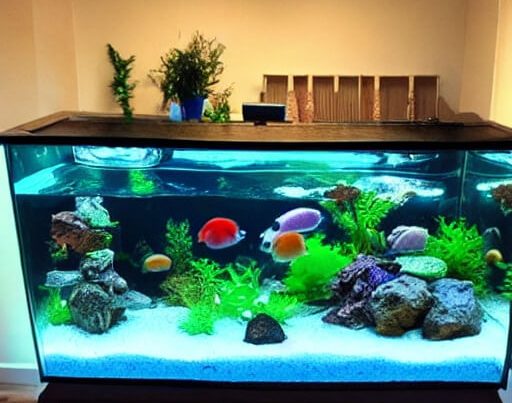The death of a pet fish can be a difficult experience, but it is important to clean the tank thoroughly afterward. A dirty tank can lead to poor water quality or the spread of disease among other fish. Cleaning a tank after a fish dies requires special attention and care in order to ensure that the tank is safe for future inhabitants. In this article, we will discuss the steps necessary to properly clean a tank after a fish has died in order to restore it to its original condition.

Importance of Cleaning a Tank After a Fish Dies
It is important to clean a tank after a fish dies in order to keep the other fish safe from disease and to maintain the water quality of the environment. The first step is to remove the dead fish from the tank with a net or by hand, being careful not to cause any trauma to the other inhabitants of the tank. Once removed, it should be disposed of safely and away from any other aquatic environments. After that, it’s time for cleaning out any uneaten food and waste particles left behind by the deceased fish, such as uneaten flakes or pellets. This helps reduce levels of ammonia and nitrate in the water which can be toxic if they reach high levels. Finally, test your tank’s pH level and add aquarium salt if necessary in order to make sure all bacteria levels are low enough for healthy living conditions for your remaining fish.
Here we’ll discuss more details in different steps:
Necessary Supplies for Fish Tank with Dead Fish
Clear Water: To begin the process of cleaning a tank after a fish has died, it is important to first empty out all of the water in the tank and replace it with clean, fresh water. This will help remove any toxins or bacteria left behind by the dead fish. Make sure to use a water conditioner when adding new water, as this will help keep your tank at an optimal pH level for your new fish.
Cleaning Supplies: To clean the tank itself, gather supplies such as paper towels, vinegar or bleach-based cleaners, and soft brushes designed specifically for aquariums. Vinegar can be used to scrub away any algae build-up on the walls or decorations while bleach-based cleaners can be used to disinfect any surfaces touched by the dead fish. Be sure to rinse off all cleaning supplies before putting them back in your tank and allow adequate time for everything to dry completely before reintroducing your new fish.
Gravel Vacuum: Lastly, using a gravel vacuum is essential for removing any debris that has accumulated on the bottom of your tank from food scraps and other waste products from your previous fish. This will ensure that there are no hazardous materials lingering in your aquarium that could potentially harm or stress out incoming livestock.
Remove the Deceased Fish From the Tank
Removing the deceased fish from the tank is an important step when cleaning a tank after a fish has passed away. There are several techniques you can use to do this, depending on the size of the fish and the type of tank.
If your tank has an exposed top, use rubber gloves and put your hand in to grab it out. If there is not enough room for that, you can use a net or some other tool that allows you to scoop it out easily. Be careful not to leave any pieces behind as they can decompose and contaminate the water quality.
For larger tanks with tight access points, it’s best to employ a siphon hose or vacuum device designed for aquariums. This will allow you to suck out all debris from inside without having to reach inside and risk damaging anything in the process. To make sure all parts of the deceased fish have been removed, empty out about 20-25% of your tank’s water as well during this process so any remaining pieces can be seen more easily.
Transfer Living Fish to a Hospital Tank
Transferring any surviving fish to a hospital tank is essential for their health and safety. It is important that the new tank is properly set up before adding any fish, as the change in environment could be fatal to them. The water should be of similar temperature, pH levels, and hardness as the original tank. Any decorations or substrate from the old tank should also be added to create a more familiar environment for the fish.
Once the hospital tank has been prepared, it’s time to move the fish over. They can either be moved by scooping them out with a net into a container with some of their original water, or by floating them in an opaque bag that contains some of their original aquarium water until they slowly acclimate themselves to the new tank’s conditions. When transferring them into the hospital tank, it’s important not to disturb them too much; if necessary, add additional decor or plants so they have plenty of places to hide throughout this transition period.
Finally, monitor all transferred fish closely for signs of stress and make sure that you are providing good filtration and aeration in order for them to thrive in their new home. Cleaning out an aquarium after one of its inhabitants dies can be difficult but taking care when moving any surviving fish will ensure their well-being long-term.
Cleaning the Tank and Decorations
A siphon should be used to remove any leftover food or waste that may have accumulated in the tank. To use a siphon, first ensure that the tube is securely attached to one end of the hose. Place the other end of the hose into a bucket or container filled with water and plunge it up and down until a steady flow of water is created. Slowly move the tube around different areas of the tank bottom, paying close attention to corners and crevices where debris can become trapped.
Once all visible debris has been removed, place an aquarium vacuum cleaner into your tank and begin vacuuming any remaining dirt or algae off of glass walls and decorations. Change out water as needed while cleaning, ensuring that all dirt has been suctioned away before replacing it with new water. Finally, scrub any decorations vigorously with warm soapy water on both sides before setting them back in your fish tank for their next inhabitant!
Use Mild Detergent and Hot water to Clean Any Decorations or Rocks
Hot water and mild detergent are highly effective when used to clean decorations and rocks in a tank. When cleaning, it is important to use only hot water, as cold water may not be enough to remove any existing debris or dirt. Furthermore, the use of mild detergent is recommended to keep from damaging any materials that could be present within the tank. When washing all items, make sure to scrub off any visible residue that may still linger on them prior to submerging them in the hot soapy water.
After everything has been submerged for at least five minutes, carefully remove each item and rinse thoroughly with warm water until no soap remains. To ensure all traces of dirt have been eliminated, try using an old toothbrush or soft-bristled brush on stubborn areas before rinsing again. Once everything is fully rinsed off, they are now safe to return back into the tank.
Replacing the Water & Filter Media
Replacing the water and filter media is an important part of cleaning your tank after a fish has died. It is best to do this before adding more fish or other inhabitants. The goal of changing out the water and filter media is to remove any toxins, bacteria, and parasites that can accumulate over time in the tank due to the decomposition of organic matter from dead fish.
To replace the water and filter media:
- Start by draining half of the tank’s contents into a bucket.
- Next, clean out any debris or waste in the substrate using a gravel vacuum cleaner.
- Then, use a high-quality aquarium water conditioner to neutralize chlorine and chloramines found in tap water for refilling your tank. Replace with pre-conditioned dechlorinated tap water that matches both temperature and pH levels as closely as possible to what was removed from the tank earlier.
- Finally, replace all activated carbon or other chemical filtration media bags at least once per month for optimal performance of your filtration system.
Refill & Treat Tank Water
Water conditioners are essential for restoring balance to a tank after a fish’s death. They help to neutralize any toxins that have been released into the water, as well as help to bring the pH levels back up. When adding water conditioner, it is important to distribute it evenly throughout the entire tank so that all areas of the water are being treated. Depending on the size of your tank and its contents, you may need to use more or less of the product in order for it to be effective.
It is also important to monitor your pH levels before and after adding water conditioner. The ideal range for a freshwater aquarium should be between 6.5-7.5; higher than this can cause stress in fish and other aquatic life, while lower than this could lead to bacterial growth or even an ammonia spike which could kill off all of your fish if left untreated. If there is a drastic change in these levels then you should consider using an additional filter such as an air stone or sponge filter as well as regularly changing out some of the old tank water for fresh new water on a regular basis. This will ensure that all harmful toxins have been removed from your aquarium environment and that your fish are safe from harm going forward.
Monitor Tank Water Quality
When a fish dies in an aquarium, the tank’s water quality can suffer. This can be caused by the build-up of toxins from the decomposing fish, as well as any uneaten food or waste that was not removed properly. To maintain healthy tank conditions and prevent long-term damage to other fish, it is essential to monitor water quality and take action if necessary.
The first step is to test for ammonia levels in your tank water. Ammonia levels should remain below 0.02 mg/L; anything above this can be toxic to fish and invertebrates living in the tank. If you detect high levels of ammonia, use a product such as Stress Zyme or AquaSafe Plus that will break down the toxins into safer compounds that are easier for your filter system to manage.
Once you have addressed any ammonia issues, it is important to check other parameters such as pH and nitrate levels in order to keep your tank clean and healthy over time. You may need to adjust these values with additives if they become too low or too high for your particular species of fish or invertebrates living in your aquarium. Regular testing will help you understand what levels are normal for your specific setup so you know when changes need to be made.
Put the Remaining Fish Back or Add New Fish
When putting the remaining fish back into the tank, it’s important to take a few steps to ensure their safety. First, it is best to use a net or slotted spoon when transferring the fish. Ensure that any plants and decorations are free of debris before placing them back in the tank. It is also important to make sure that all water parameters, such as temperature and pH, remain consistent for the remaining fish. This will reduce stress on the fish from sudden changes in their environment.
When adding new fish, it is essential to gradually increase both temperature and pH levels so as not to shock them with sudden changes in their environment. Also, be sure to quarantine any new additions for at least two weeks prior to introducing them into the main tank. During this time, monitor closely for signs of disease or parasites and treat them accordingly if necessary before releasing them into your aquarium. Lastly, research fully on any species you plan on purchasing so you understand its requirements for proper care – this will help make sure your new pets last long-term!
Conclusion
In conclusion, cleaning a tank after a fish dies is an important part of fishkeeping. By removing the carcass as soon as possible and thoroughly cleaning the tank with vinegar and hot water, you can keep your tank clean and ensure that any potential diseases are not spread to other fish.
Additionally, performing 25-50% water changes on a regular basis can help maintain healthy living conditions for your aquatic pets.
Lastly, it is important to use dechlorinated water whenever introducing new water into the tank to avoid stressing out your existing inhabitants or introducing toxins into the environment. With these simple steps in mind, you can make sure that your aquarium remains clean and habitable for all its inhabitants.




